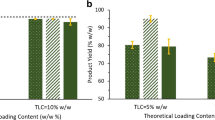Abstract
The metabolic fate of a new, oil soluble antioxidant, selected from a series representing a unique class of phenolic polymers, is discussed together with its activity in unsaturated vegetable oils as compared to butylated hydroxytoluene, butylated hydroxyanisole, and tertiary butylhydroquinone (TBHQ). Using gel permeation chromatography,14C-radiolabeled polymer was isolated into discrete mol wt fractions and these administered as single oral doses to rats. Results indicate that while monomeric14C-TBHQ with a mol wt of 166 shows a total absorption of 88.3% of the administered dose, the absorption of polymeric antioxidant is vastly reduced with increasing mol wt; i.e., mol wt 760: 1.5%, mol wt 7300:0.44%, and mol wt 67,000: 0.34%. Functionality tests using the active oxygen method indicate that by increasing the phenolic constituents in the polymer composition the antioxidant activity can surpass that of certain traditional, monomeric food grade antioxidants. Stability tests using thermogravimetric analysis indicate the polymeric antioxidants are not depolymerized in the presence of air at temperatures up to 300 C. Further, the polymers are nonvolatile and under deep frying conditions result in nearly quantitative carry-through of antioxidant in that portion of oil absorbed by the food; a monomeric food grade antioxidant (TBHQ) shows losses due to volatilization.
Similar content being viewed by others
References
Branen, A.L., JAOCS 52:59 (1975).
Gilbert, D., and L. Golberg, Food Cosmet. Toxicol. 3:417 (1965).
Botham, C.M., D.M. Conning, J. Hayes, M.H. Litchfield, and T.F. McElligott, Ibid. 8:1 (1970).
Lane, B.P., and C.S. Lieber, Lab. Invest. 16:342 (1967).
Brown, W.D., A.R. Johnson, and M.W. O’Halloran, Aust. J. Exp. Biol. Med. Sci. 37:533 (1959).
Denz, F.A. and J.G. Llaurado, Brit. J. Cxptl. Pathol. 38:515 (1957).
Sporn, A., and O. Schobesch, Microbiol. Parazitol. Epidemiol. 9:113 (1961).
Allen, J.R., and J.F. Engblom, Food Cosmet. Toxicol. 10:769 (1972).
Seal, P., P.A. Riley, and D.R. Inman, J. Invest. Dermatol. 52:264 (1969).
Woods, D.A., and C.J. Smith, Exp. Mol. Pathol. 10:107 (1969).
Clapp, N.K., R.L. Tyndall, and R.B. Cumming, Food Cosmet. Toxicol. 11:847 (1973).
Kamra, O.P., Int. J. Radiat. Biol. 23:295 (1973).
Feuer, G., L. Golberg, and J.R. LePelly, Food Cosmet. Toxicol. 3:235 (1965).
Gaunt, I.F., D. Gilbert, and D. Martin, Ibid. 3:445 (1965).
Pascal, G., Ann. Nutr. Aliment. 23:73 (1969).
Creavan, P.J., W.H. Davies, and R.T. Williams, J. Pharm. Pharmacol. 18:485 (1966).
Gilbert, D., and L. Golberg, Food Cosmet. Toxicol. 5:481 (1967).
Pascal, G., and T. Terroine, C.R. Acad. Sci. Ser. D 268:1529 (1969).
Sporn, A., and I. Dina, Rev. Roum. Biochim. 4:301 (1968).
Hathaway, D.E., Adv. Food Res. 15:1 (1966).
Pascal, G., Arch. Sci. Physiol. 24:37 (1970).
Johnson, A.R., and E.S. Holdsworth, J. Nutr. Diet. 5:147 (1968).
Ramwell, P.W., J.E. Shaw, G.B. Clarke, M.F. Grostic, D.G. Kaiser, and J.E. Pike, in “Progress in the Chemistry of Fats and Other Lipids,” Vol. IX, Edited by R.T. Holman, Pergamon Press, Oxford, England, 1968, p. 233.
Johnson, A.R., Food Cosmet. Toxicol. 3:371 (1965).
Stokes, J., and C.L. Scudder, Dev. Phychobiol. 7:343 (1974).
Branen, A.L., H.C. Chang, G. Lenz, and J. Surak, Paper presented at the Annual Food Research Institute Meeting, Chicago, IL, October, 1973.
Milner, S.M., Nature 216:557 (1967).
Daniel, J.W., J.C. Gage, D.I. Jones, and M.A. Stevens, Food Cosmet. Toxicol. 5:475 (1967).
Kotera, A., in “Power Fractionation” Edited by M.J.R. Cantow, Academic Press, New York, NY, 1967, pp. 43–66.
“Official and Tentative Methods of the American Oil Chemists’ Society, Vol. I and II, 3rd Edition, AOCS, Champaign, IL, 1973 (revised yearly), Method Cd 12-57.
Ibid., Method Cd 8-53.
Cort, W.M., Food Technology 28:60 (1974).
Kopelman, I.J., S. Mizrahi, and R. Schab, JAOCS 52:103 (1975).
Eastman Chemical Products, Publication No. ZG-201, pp. 3 (1972).
Hathaway, D.E., Advances in Food Research 15:1–55, Academic Press (1966).
Author information
Authors and Affiliations
About this article
Cite this article
Furia, T.E., Bellanca, N. Development of new, nonabsorbable polymeric antioxidants for use in foods. J Am Oil Chem Soc 53, 132–137 (1976). https://doi.org/10.1007/BF02586350
Received:
Issue Date:
DOI: https://doi.org/10.1007/BF02586350




